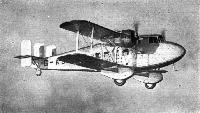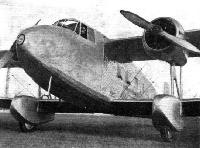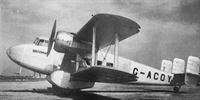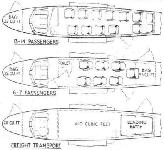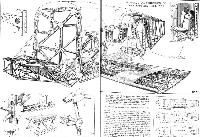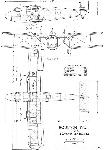Jane's Encyclopedia of Aviation
Boulton Paul P.71A (UK)
Twin-engined highspeed commercial biplane, designed for feederline service with Imperial Airways. Seating for seven passengers in the main cabin.
Показать полностьюShow all
Flight, January 1935
IMPERIAL AIRWAYS' LATEST
A New Type for Feeder-line Work: The Boulton Paul P71A, which Follows the General Lines of the "Mailplane"
KNOWN in the makers' works at Norwich as the P.71A, this new Boulton Paul production has been especially built to the order of Imperial Airways, and two of the type are shortly being delivered for feeder-line work, where a high cruising speed, comfort for the passengers, a quick take off and short landing are required. When compared with that of other modern transport aeroplanes the performance of the P.71A is not particularly startling, but in this connection it should be remembered that it has been built to Imperial Airways' own specification and must be assumed to have the performance they require.
Basically, the P.71A machine springs from the "Mailplane," details of which were published in Flight for April 6, 1933. There are, however, several structural differences which make it most interesting from an engineering point of view. As with the "Mailplane," it is a two-bay biplane with two engines mounted high up between the wings directly above the widely spread wheels of the undercarriage. The engines, which are two Armstrong Siddeley "Jaguar VIA's" from Imperial Airways' stock, are mounted on built-up duralumin ring-type mountings slung from the underside of the top planes by steel tubes and built-up girders, and cowled with Townend ring form cowlings. These mountings coincide with the inner interplane struts and the points at which each separate half of the undercarriage is attached beneath the lower planes.
The sketches explain the construction of the undercarriage, and from the photographs it can be seen how neatly each half is faired in. The Dunlop wheels, which have Dunlop brakes, are carried between oleo-pneumatic shock-absorbing legs. The fairings are detachable and are fabric covered structures of spruce, light stringers being bent round formers to carry the fabric. This system of building up fairings has been used for a number of other places on the machine, notably under and above the fuselage between the wings, and round the nose of the fuselage, their detachability being a useful feature.
Fuel is carried in four riveted duralumin tanks. Two, having a capacity of 65 gallons each, are placed one on each side of the fuselage in the roots of the top-wing centre-section; the other two, of 28 gallons each, are mounted one on each side in the top wing sections outside the engines. The lubricating-oil tanks are of the same construction and form part of the leading edge of the top planes above each engine.
No hard-and-fast rule has been adhered to with regard to the material used for construction in the P.71A. In many places light alloy is used extensively, while in others, where the stresses are high, steel has been used. Even the form of construction has been varied considerably. The front end of the fuselage, where it forms the pilot's cockpit, consists mainly of duralumin tubes secured at the joints either by flattening the tube ends and riveting them between flitch plates, or by using machined fittings. The rear half of the fuselage - that is, abaft the passenger cabin and luggage compartment - is also built up in the same manner with duralumin tubes bracing steel longerons, but is covered with doped fabric stretched over spruce formers and stringers.
The centre portion of the fuselage is entirely different in construction. Its general form is somewhat analogous to flying-boat-building practice, that is to say, the main structure is formed of built-up channel section duralumin girders over which is riveted a corrugated Alclad sheet covering. This centre portion forms the passenger cabin with accommodation for a maximum of fourteen passengers. At the front end of the cabin, just behind a bulkhead which separates it from the pilot's cockpit - access to which is by a large door, and which, incidentally, has a "sunshine" roof made to slide open easily - there is a well-fitted lavatory.
Particular attention has been paid to the comfort provided for the passengers. The cabin ventilation is on the "total" system, that is to say, warm or cold air is introduced through a large single inlet and exhausted in the same manner, the system being so arranged that all the air in the cabin is changed continuously. Rumbold's, who have established themselves as upholsterers to the aircraft trade, have looked after all the furniture and fitments in the cabin, as well as the sound-proofing, which is achieved in part by a padding of "Sepak" in the space - the depth of the structural girders - left of necessity between the outer Alclad shell and the inner lining.
A point of interest is the system adopted for operation of the controls. From the pilot's cockpit to the controllable surfaces there are, for the most part, tie rods; where it is necessary to carry them round corners they are connected to chains running over sprockets. Numbers of inspection doors are provided, while the detachable fairing around the cockpit makes inspection of the whole system a simple matter. A locking device secures the controls when on the ground, and prevents damage due to flapping in the wind.
The tail units are unusual. The tail plane is a monoplane with a built-up duralumin spar and ribs of the same material, and is adjustable for trim by a screw gear. It carries a single central fin, also of metal construction, and two rudders. These latter are placed well towards the ends of the tail plane spar, one on each side of the fin. Rudder posts project above and below the spar and operate top and bottom rudder surfaces. The Dowty tail wheel is of the streamlined and self-centring type - a small point which is often overlooked but which saves quite a considerable drag when, as in the P.71A, cruising speeds of 150 m.p.h. are attained.
From an engineering point of view the P.71A is extremely interesting; the way in which different materials are used according to the work they have to perform shows that much thought has been put into producing a sound structure. The ratio of gross weight to tare weight is 1.56, a good average figure, probably sufficient to make the P.71A a sound commercial proposition for the work for which it is required, but scarcely high enough to allow it to be used really economically over long distances.
One of its more attractive features is its performance on one engine; a ceiling of 4,500 ft. (1 372 m) is claimed on either engine. The comparatively low wing-loading - only 13.25 lb./sq. ft. (64.7 kg/m2) – and low power loading of about 11.17 lb./h.p. (5 kg/h.p.) should ensure a good performance on aerodromes which are situated at high altitude and in countries where the heat affects the performance adversely; it would seem probable that it is for conditions of this nature that Imperial Airways have made these two latest additions to their fleet. Certainly, for overseas conditions particularly, where the aerodromes are soft or where the run available for taking off is short, a machine which takes off with full load in 200 yd. (183 m) and lands in the same distance should be a blessing and a joy to the pilots, as well as a saving from the point of view of aerodrome costs.
Both the Britomart and Boadicea, as the first two machines of this type will be called when flying the Imperial Airways flag, are fitted to carry six or seven passengers in great comfort. With the cabin accommodation limited to this number there will be a superabundance of leg room, considerable space for luggage and perhaps mails, and ample load left for very complete wireless, navigational, blind-flying and night-flying equipment.
Other schemes can, of course, be arranged to suit individual requirements. For example, our diagram shows a layout which provides for fourteen passengers. In this form the P.71A would be very suitable for short-distance shuttle services between two towns which normally want good transport connection but which are separated by bad country or by water. Where there is no need to provide for passengers at all the complete cabin can be left clear for freight, and then there is a space of no less than 410 cu. ft. (11,6 m3) into which freight can be loaded.
An interesting point about the machine as a whole is the family resemblance it bears to the military machines made by the same firm, notably the "Overstrand." Designers who produce fast civil machines generally do so ab initio, as it were, and it is not very often that we see a civil machine, particularly a biplane, wherein the performance has largely been secured by utilising the lessons learnt in military aircraft following a somewhat similar layout.
Boulton Paul have their own wind tunnel, and, therefore, are in a position to design in the light of their own basic investigations, so that, despite the fact that a biplane probably offers more possibilities of aerodynamic interference between the component parts than does a monoplane, they have been able to produce, in the "Overstrand" type, a machine comparing more than favourably with aircraft which rely on but one wing for their support in the air.
Показать полностьюShow all


